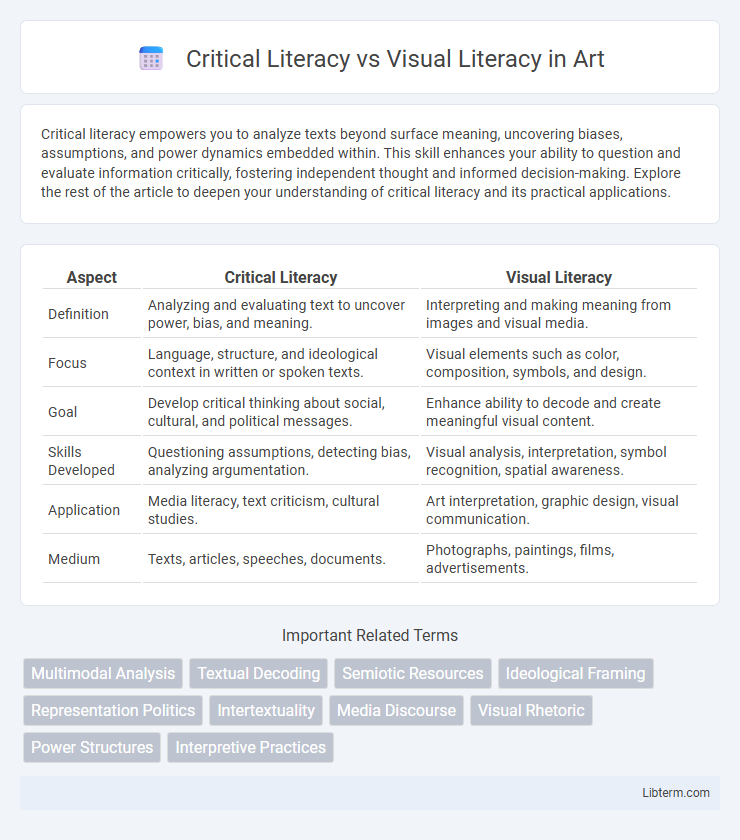Critical literacy empowers you to analyze texts beyond surface meaning, uncovering biases, assumptions, and power dynamics embedded within. This skill enhances your ability to question and evaluate information critically, fostering independent thought and informed decision-making. Explore the rest of the article to deepen your understanding of critical literacy and its practical applications.
Table of Comparison
| Aspect | Critical Literacy | Visual Literacy |
|---|---|---|
| Definition | Analyzing and evaluating text to uncover power, bias, and meaning. | Interpreting and making meaning from images and visual media. |
| Focus | Language, structure, and ideological context in written or spoken texts. | Visual elements such as color, composition, symbols, and design. |
| Goal | Develop critical thinking about social, cultural, and political messages. | Enhance ability to decode and create meaningful visual content. |
| Skills Developed | Questioning assumptions, detecting bias, analyzing argumentation. | Visual analysis, interpretation, symbol recognition, spatial awareness. |
| Application | Media literacy, text criticism, cultural studies. | Art interpretation, graphic design, visual communication. |
| Medium | Texts, articles, speeches, documents. | Photographs, paintings, films, advertisements. |
Understanding Critical Literacy
Critical literacy involves analyzing texts to uncover underlying power structures, ideologies, and biases, fostering deeper comprehension and questioning of written or spoken content. It encourages readers to challenge assumptions and recognize the social and political contexts influencing the message. Developing critical literacy skills enhances the ability to interpret and critique information critically across various media forms.
Defining Visual Literacy
Visual literacy refers to the ability to interpret, negotiate, and make meaning from information presented in the form of images. It involves understanding visual conventions, symbols, and context to critically analyze and create visual content. Developing visual literacy enhances comprehension in multimedia environments by integrating perception, cognition, and cultural knowledge.
Key Differences between Critical and Visual Literacy
Critical literacy emphasizes analyzing and questioning texts to uncover power dynamics, biases, and social contexts, while visual literacy focuses on interpreting and understanding images and visual media. Critical literacy develops skills in evaluating language, ideology, and persuasive techniques, whereas visual literacy enhances the ability to decode symbols, composition, and visual messages. Both literacies involve interpretation, but critical literacy addresses deeper socio-political meanings, and visual literacy prioritizes visual perception and communication.
Historical Development of Both Literacies
Critical literacy emerged in the 1980s as an educational approach focused on analyzing and challenging power dynamics embedded in texts, rooted in Paulo Freire's theories on pedagogy and social justice. Visual literacy, tracing back to early 20th-century art education and media studies, evolved alongside technological advances in photography, film, and digital media, emphasizing the interpretation and creation of meaningful visual messages. Both literacies have developed in response to societal changes, with critical literacy addressing ideological influences and visual literacy adapting to the proliferation of visual communication in contemporary culture.
Core Skills in Critical Literacy
Core skills in critical literacy involve analyzing and evaluating texts to identify underlying power structures, biases, and assumptions, enabling deeper comprehension beyond surface meaning. This includes questioning author intent, recognizing persuasive language, and examining cultural and social contexts within written content. In contrast, visual literacy focuses on interpreting and creating meaning through images, symbols, and visual media, emphasizing skills such as visual decoding, spatial awareness, and symbolic interpretation.
Essential Competencies in Visual Literacy
Essential competencies in visual literacy include the ability to interpret, analyze, and evaluate visual information accurately, recognizing the use of symbols, colors, and design elements to convey meaning. Mastery of visual literacy enables individuals to critically assess images in media, advertisements, and digital content, fostering informed decision-making and awareness of potential biases. These skills complement critical literacy by expanding comprehension beyond text to include multimodal communication in contemporary contexts.
The Role of Media in Shaping Literacies
Media plays a crucial role in shaping both critical literacy and visual literacy by influencing how individuals interpret and evaluate information. Critical literacy involves analyzing media messages to uncover underlying power dynamics, biases, and ideologies embedded within texts and visual representations. Visual literacy complements this by enabling viewers to decode, understand, and critically assess the meaning and impact of images across diverse media platforms.
Integrating Critical and Visual Literacy in Education
Integrating critical literacy and visual literacy in education enhances students' ability to analyze and interpret both text and images, fostering deeper comprehension and critical thinking skills. Combining these literacies enables learners to decode complex media messages and understand underlying social, cultural, and political contexts. This interdisciplinary approach prepares students for navigating diverse information environments in the digital age effectively.
Challenges in Teaching and Assessing Both Literacies
Teaching critical literacy involves challenges such as encouraging students to analyze underlying power structures and ideological biases, which requires deep cognitive skills and may encounter resistance due to sensitive content. Visual literacy instruction faces difficulties in helping learners decode complex symbols, cultural contexts, and media aesthetics, demanding diverse multimodal competencies that are often underdeveloped in standardized curricula. Assessing both literacies is complicated by the subjective nature of interpretation, the need for authentic tasks that reflect real-world analysis, and the limited availability of reliable, validated assessment tools that capture critical thinking and visual comprehension simultaneously.
The Future of Literacy in a Multimodal World
Critical literacy equips individuals to analyze and question power structures within texts, fostering deeper understanding of social contexts, while visual literacy empowers interpretation of images and multimedia as complex communication forms. The future of literacy in a multimodal world demands integration of both skills, enabling individuals to navigate and critically assess diverse information across digital platforms. Developing competence in critical and visual literacies supports effective engagement with evolving media landscapes, enhancing informed decision-making and cultural awareness.
Critical Literacy Infographic

 libterm.com
libterm.com